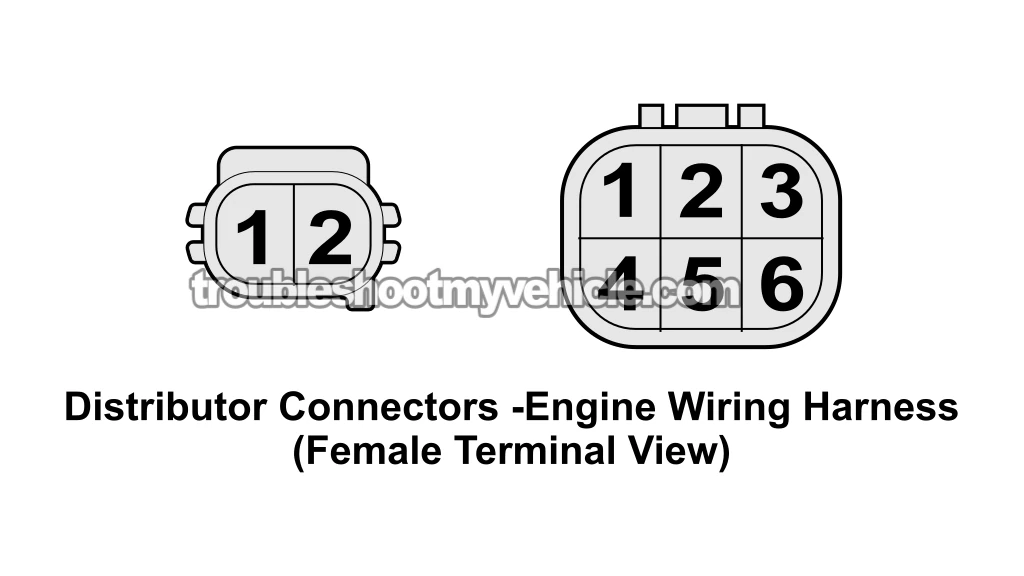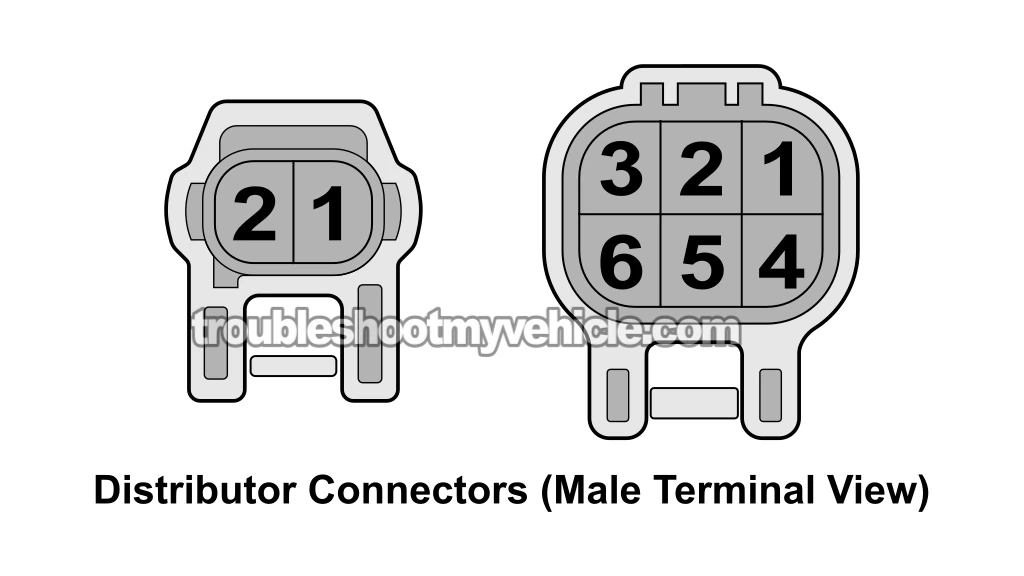
The igniter (ignition control module) is the ignition system component that activates the ignition coil to fire spark. I can tell you from personal experience that testing it to find out if it's good or bad isn't difficult at all.
In this tutorial, I'm gonna show you my way of seeing if it's activating the ignition coil or if it's fried and needs to be replaced.
Contents of this tutorial:
- Symptoms Of A Bad Igniter.
- Distributor Connector Circuit Descriptions.
- How the Igniter Works.
- TEST 1: Making Sure The Igniter Is Getting Power.
- TEST 2: Making Sure The Igniter Is Getting Ground.
- TEST 3: Testing The Igniter Control Signal.
- TEST 4: Testing The Ignition Coil Activation Signal.
- More 1.8L Toyota Corolla Tutorials.
APPLIES TO: This tutorial applies to the following vehicles:
- 1.8L 7A-FE Toyota Corolla: 1993, 1994.
- 1.8L Geo Prizm: 1993, 1994.
IMPORTANT: Before testing the igniter, check the ignition coil for spark first.
If you've got spark from even just one spark plug wire, the igniter's working fine and you don't need to go any further. If you haven't tested the ignition coil yet, this tutorial will help you do that:
Ignition System Wiring Diagrams:
Distributor Pickup Coil Tests:
Engine No-Start Basics:
Symptoms Of A Bad Igniter
The igniter (ignition control module) is a key part of the ignition system. As you're probably already aware, it's located inside the distributor. When it fails, the engine's not gonna get the spark it needs to start and run.
Basically, the igniter and the fuel injection computer team up to:
- Activate the ignition coil: The computer sends an ignition trigger (IGT) signal to the igniter, which then switches the ignition coil on and off to fire the spark plugs.
- Manage ignition timing: Based on sensor inputs, the computer decides when to fire the spark and sends a command to the igniter, which then switches the ignition coil on and off to make it happen.
- Enable the fuel injectors and fuel pump: Every time the igniter activates the ignition coil to fire spark, it sends back an ignition confirmation (IGF) signal to the computer. If the computer doesn't get this signal, it assumes there's no spark and shuts off the fuel injectors and, in most cases, the fuel pump.
If the igniter stops working, the ignition coil won't spark, which means the spark plugs won't fire either. On top of that, the fuel pump and injectors won't switch on. No spark, no fuel —so the engine's not gonna start.
Distributor Connector Circuit Descriptions
You'll find the igniter inside the distributor, underneath the distributor cap. The distributor's got two connectors —one with two wires and another with six.
Each wire carries a specific signal. Here's a quick breakdown of what they do:
2-Wire Connector:
| Pin | Wire Color | Description |
|---|---|---|
| 1 | Black with orange stripe (BLK/ORG) | B+ → Ignition 12 Volts |
| 2 | Black (BLK) | IG- → Tachometer Signal |
6-Wire Connector:
| Pin | Wire Color | Description |
|---|---|---|
| 1 | Black (BLK) | IGT → Ignition Timing Signal |
| 2 | White (WHT) | NE- → Sensor Ground For NE Signal |
| 3 | Green (GRN) | G- → Sensor Ground For G1 Signal |
| 4 | Black with yellow stripe (BLK/YEL) | IGF → Ignition Feedback Signal |
| 5 | Black (BLK) | NE → Engine Speed Signal |
| 6 | Red (RED) | G1 → Crankshaft Position Signal |
Ignition System Wiring Diagram:
NOTE: The distributor harness connector has female terminals, while the connector coming out of the distributor itself has male terminals.
How the Igniter Works
Cranking the engine, on your 1993-1994 1.8L Toyota Corolla, sets in motion a series of events to supply spark to all four spark plugs and get it to start and keep it running.
Here's what happens:
- Igniter and ignition coil get power: The ignition switch sends 10 to 12 Volts DC straight to the igniter and ignition coil.
- This voltage is delivered to these components by the black with orange stripe (BLK/ORG) wire of the distributor's 2-wire connector.
- Pickup coil signals: As the engine turns over, the pickup coil inside the distributor generates the G1 and NE signals and shoots them straight to the fuel injection computer.
- Igniter activation: Once those signals reach the computer, it sends out an ignition timing (IGT) signal to the igniter.
- This IGT signal tells the igniter exactly when to fire the ignition coil.
- It's delivered by the black (BLK) wire, which connects to terminal number 1 of the distributor's 6-wire connector.
- Ignition coil activation: Once the igniter gets the IGT signal, it fires off the +B2 activation signal straight to the ignition coil.
- The +B2 signal makes the ignition coil generate spark.
- IGF signal: After the ignition coil fires, the igniter shoots an ignition feedback (IGF) signal back to the fuel injection computer.
- This IGF signal confirms that the ignition coil fired, which tells the fuel injection computer it's good to activate the fuel pump and injectors.
Now that you've got a solid grasp on how everything works, let's jump into testing the igniter.
TEST 1: Making Sure The Igniter Is Getting Power

IMPORTANT: If even one spark plug wire is firing spark (as confirmed by a spark test with a dedicated spark tester), then the igniter's doing its job just fine. That means you don't need to test the igniter. So before you start, please check the spark plug wires for spark:
First thing we're gonna do to kick off this igniter test is grab a multimeter and check if the igniter is getting power (10 to 12 Volts DC).
The black with orange stripe (BLK/ORG) wire is the one that delivers this voltage to the igniter.
In the illustration of the distributor connectors above, terminal number 1 of the distributor's 2-wire connector is the one that corresponds to the BLK/ORG).
Once we confirm there's power reaching the igniter, we'll move on to TEST 2.
NOTE: This test is done on the 2-wire engine wiring harness connector -not the connector that comes out of the distributor itself. This 2-wire engine wiring harness connector has female terminals.
Here's what you need to do:
- 1
Disconnect the distributor's 2-wire electrical connector.
- 2
Touch the black multimeter test lead to the battery's negative (-) terminal.
- 3
Have your helper turn the key to the ON position.
- 4
Set your multimeter to Volts DC mode.
- 5
Gently probe female terminal number 1 (on the 2-wire connector) with the red multimeter test lead.
NOTE: Double-check that female terminal number 1 on the 2-wire connector corresponds to the BLK/ORG wire. - 6
Your multimeter should read between 10 and 12 Volts DC.
Here's what your results mean:
CASE 1: Terminal 1's voltage is between 10 and 12 Volts. That's exactly what you should see.
Now, we're gonna check if the igniter's getting Ground. To do that, head over to: TEST 2: Making Sure The Igniter Is Getting Ground.
CASE 2: Terminal 1 isn't showing the expected voltage. That means the igniter's not working 'cause it's not getting power from the ignition switch.
Your next move? Track down what's cutting off that power and fix it. Once ignition voltage is restored to the BLK/ORG wire, the igniter should kick back to life.
TEST 2: Making Sure The Igniter Is Getting Ground
Since TEST 1 confirmed the igniter's getting power, the next thing we gotta check is whether it's got a solid Ground connection.
Unlike most engine management parts that have a dedicated Ground wire, the igniter gets its Ground straight through its metal case.
You already know the igniter's bolted to the distributor with two screws. Since the distributor's mounted on the cylinder head, that creates a direct path to chassis Ground.
To see if it's Grounded, we're gonna check for continuity between the igniter's metal case and the battery's negative (-) terminal.
If it's Grounded correctly, your multimeter should show continuity.
Alright, let's get to it:
- 1
Disconnect the battery's positive (+) cable from the positive (+) terminal.
NOTE: Leave the battery's negative (-) cable connected. - 2
Remove the distributor cap.
- 3
Set your multimeter to Ohms (Ω) mode.
- 4
Touch one of the multimeter leads to the igniter's metal case.
- 5
Place the other lead on the center of the battery's negative (-) terminal.
- 6
The multimeter should show continuity.
If you see continuity (a reading under 1 Ohm), then the igniter's got a good Ground connection.
If there's no continuity (infinite resistance or OL on the screen), the igniter isn't Grounded.
Here's what your test results mean:
CASE 1: The igniter's got continuity to Ground. That's exactly what you should see.
Next up, we're gonna check if the igniter's receiving the IGT signal from the fuel injection computer. Head over to: TEST 3: Testing The Igniter Control Signal.
CASE 2: The igniter DOES NOT have continuity to Ground. That usually points to corrosion or a bad connection between the igniter's case and its mounting spot.
Inspect those mounting points and clean 'em up to ensure a solid metal-to-metal connection. Once the case is properly Grounded, the igniter should work like it's supposed to.

